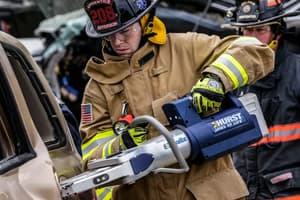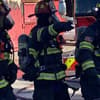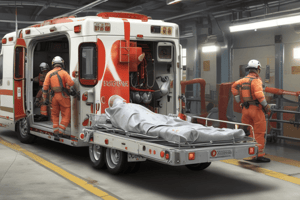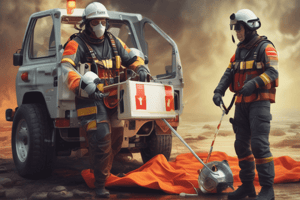Podcast
Questions and Answers
What is the primary responsibility of the Extrication Sector Officer regarding patient assessment?
What is the primary responsibility of the Extrication Sector Officer regarding patient assessment?
- To perform medical treatment on the patients
- To determine the location, number, and condition of all patients (correct)
- To assign medical personnel to attend to patients
- To provide transportation for patients to a hospital
How should face-to-face communication be facilitated within the Extrication Sector?
How should face-to-face communication be facilitated within the Extrication Sector?
- By utilizing a public address system
- Through direct conversation between the sector officer and company officers (correct)
- Using written messages passed between officers
- By having all personnel wear headsets
When is it allowed to move 'DELAYED' patients before 'IMMEDIATE' patients?
When is it allowed to move 'DELAYED' patients before 'IMMEDIATE' patients?
- In cases of confined entrapment where access to 'IMMEDIATE' patients is restricted (correct)
- When 'DELAYED' patients are more accessible
- Only if there are additional personnel available
- When resources are insufficient for 'IMMEDIATE' patient care
What equipment may be used for transporting non-ambulatory patients?
What equipment may be used for transporting non-ambulatory patients?
What is the first priority when removing patients to the treatment area?
What is the first priority when removing patients to the treatment area?
What is required for effective triage coordination among sectors?
What is required for effective triage coordination among sectors?
What item designated for IMMEDIATE patients ensures they can be easily identified?
What item designated for IMMEDIATE patients ensures they can be easily identified?
What must the Extrication Officer do upon confirming that all patients have been removed?
What must the Extrication Officer do upon confirming that all patients have been removed?
What is the primary goal of the Extrication Officer when managing resources during an incident with numerous victims?
What is the primary goal of the Extrication Officer when managing resources during an incident with numerous victims?
When handling a situation with multiple patients, how many victims should ideally be assigned per fire company according to the guidelines?
When handling a situation with multiple patients, how many victims should ideally be assigned per fire company according to the guidelines?
In a large incident site, what is a necessary action to take regarding the Extrication Sector?
In a large incident site, what is a necessary action to take regarding the Extrication Sector?
What is the responsibility of the Company Officer in relation to patients until their transfer to another treatment area?
What is the responsibility of the Company Officer in relation to patients until their transfer to another treatment area?
When should specialized equipment like wreckers or cranes be requested?
When should specialized equipment like wreckers or cranes be requested?
What role does Triage play in managing minor (ambulatory) patients during an incident?
What role does Triage play in managing minor (ambulatory) patients during an incident?
What is the first priority for the Extrication Officer when sizing up the situation at an incident?
What is the first priority for the Extrication Officer when sizing up the situation at an incident?
Why is it important for personnel to commit to safety during the extrication process?
Why is it important for personnel to commit to safety during the extrication process?
What is NOT a standard responsibility of the Extrication Sector?
What is NOT a standard responsibility of the Extrication Sector?
In which situation should IMMEDIATE patients be moved to the treatment area without delay?
In which situation should IMMEDIATE patients be moved to the treatment area without delay?
How should the Extrication Officer maintain communication with arriving companies?
How should the Extrication Officer maintain communication with arriving companies?
What must be ensured when moving patients on backboards?
What must be ensured when moving patients on backboards?
Which aspect of incident management relies heavily on close coordination between sectors?
Which aspect of incident management relies heavily on close coordination between sectors?
When might triage be performed at the entrance to the treatment area instead of in place?
When might triage be performed at the entrance to the treatment area instead of in place?
Which of the following is an inappropriate action for the Extrication Officer once all patients are removed?
Which of the following is an inappropriate action for the Extrication Officer once all patients are removed?
What is a primary reason for using litter bearers in patient extrication?
What is a primary reason for using litter bearers in patient extrication?
What is the primary function of assigning companies to specific areas in an extensive extrication incident?
What is the primary function of assigning companies to specific areas in an extensive extrication incident?
During a large incident where extrication is necessary, what should be the first consideration for the Extrication Officer?
During a large incident where extrication is necessary, what should be the first consideration for the Extrication Officer?
What role does the Company Officer play during the extrication process?
What role does the Company Officer play during the extrication process?
What is the purpose of using green salvage covers during an incident?
What is the purpose of using green salvage covers during an incident?
When forced extrication is necessary, which type of company is specifically assigned?
When forced extrication is necessary, which type of company is specifically assigned?
If a large area incident requires multiple extrication sectors, what should guide the division of responsibilities?
If a large area incident requires multiple extrication sectors, what should guide the division of responsibilities?
What is the suggested ratio for company assignment in relation to patient numbers during an emergency incident?
What is the suggested ratio for company assignment in relation to patient numbers during an emergency incident?
Which of the following actions should be prioritized by the Extrication Sector in an incident with multiple victims?
Which of the following actions should be prioritized by the Extrication Sector in an incident with multiple victims?
Flashcards are hidden until you start studying
Study Notes
Extrication Sector Responsibilities
- Identify location, number, and condition of patients in coordination with Triage.
- Decide on the triage location: in place or at treatment area entrance.
- Assess and allocate necessary resources for extrication.
- Assign and oversee extrication teams during operations.
- Safely extricate patients and transport them to treatment areas or casualty collection points.
- Provide regular updates on progress to Command.
- Ensure safety and accountability for patients and personnel involved in the sector.
- Collaborate with other sectors for coordinated operations.
- Notify Command once all patients are extricated and companies are ready for reassignment.
Positioning and Communication
- Extrication Officer should be easily visible and accessible to arriving units.
- Use face-to-face communication within the sector for clarity.
- Utilize messengers for relaying information to the Extrication Officer as needed.
- Frequent progress reports to Command are essential for operational updates.
Triage and Patient Management
- Primary focus is on IMMEDIATE patients for swift transfer to treatment areas.
- IMMEDIATE patients are tagged with night-reflective labels for easy identification.
- Delayed patients may be extracted before IMMEDIATE patients in confined situations.
- Non-ambulatory patients must be moved using backboards with cervical spine precautions when necessary.
- Assign "litter bearers" to assist in transporting patients.
Resource Allocation and Team Coordination
- A guideline for initial deployment is one company for every five victims for effective immediate care.
- Companies should be assigned to specific patient groups in large incident areas for better management.
- Each assigned Company Officer is responsible for patients until they are transferred to the treatment area.
Specialized Equipment and Safety
- If forcible extrication is required, ladder companies must be designated for the task.
- Proximity of ladder apparatus to the scene is crucial while minimizing congestion from other units.
- Request specialized equipment (e.g., wreckers, cranes, cutting tools) through Command as needed.
- Ensuring safety in the extrication area is paramount, employing protective lines and firefighting equipment as necessary.
Collaboration and Next Steps
- Triage directs MINOR (ambulatory) patients to a designated area initially; Extrication Sector later assesses them.
- Consider moving MINOR patients to an "Assembly Area" for further management.
- Identify the assembly area using green salvage covers, potentially utilizing buses or vehicles for transport.
- Inform Command of available companies and personnel for reassignment as operations progress.
Extrication Sector Responsibilities
- Identify location, number, and condition of patients in coordination with Triage.
- Decide on the triage location: in place or at treatment area entrance.
- Assess and allocate necessary resources for extrication.
- Assign and oversee extrication teams during operations.
- Safely extricate patients and transport them to treatment areas or casualty collection points.
- Provide regular updates on progress to Command.
- Ensure safety and accountability for patients and personnel involved in the sector.
- Collaborate with other sectors for coordinated operations.
- Notify Command once all patients are extricated and companies are ready for reassignment.
Positioning and Communication
- Extrication Officer should be easily visible and accessible to arriving units.
- Use face-to-face communication within the sector for clarity.
- Utilize messengers for relaying information to the Extrication Officer as needed.
- Frequent progress reports to Command are essential for operational updates.
Triage and Patient Management
- Primary focus is on IMMEDIATE patients for swift transfer to treatment areas.
- IMMEDIATE patients are tagged with night-reflective labels for easy identification.
- Delayed patients may be extracted before IMMEDIATE patients in confined situations.
- Non-ambulatory patients must be moved using backboards with cervical spine precautions when necessary.
- Assign "litter bearers" to assist in transporting patients.
Resource Allocation and Team Coordination
- A guideline for initial deployment is one company for every five victims for effective immediate care.
- Companies should be assigned to specific patient groups in large incident areas for better management.
- Each assigned Company Officer is responsible for patients until they are transferred to the treatment area.
Specialized Equipment and Safety
- If forcible extrication is required, ladder companies must be designated for the task.
- Proximity of ladder apparatus to the scene is crucial while minimizing congestion from other units.
- Request specialized equipment (e.g., wreckers, cranes, cutting tools) through Command as needed.
- Ensuring safety in the extrication area is paramount, employing protective lines and firefighting equipment as necessary.
Collaboration and Next Steps
- Triage directs MINOR (ambulatory) patients to a designated area initially; Extrication Sector later assesses them.
- Consider moving MINOR patients to an "Assembly Area" for further management.
- Identify the assembly area using green salvage covers, potentially utilizing buses or vehicles for transport.
- Inform Command of available companies and personnel for reassignment as operations progress.
Studying That Suits You
Use AI to generate personalized quizzes and flashcards to suit your learning preferences.






